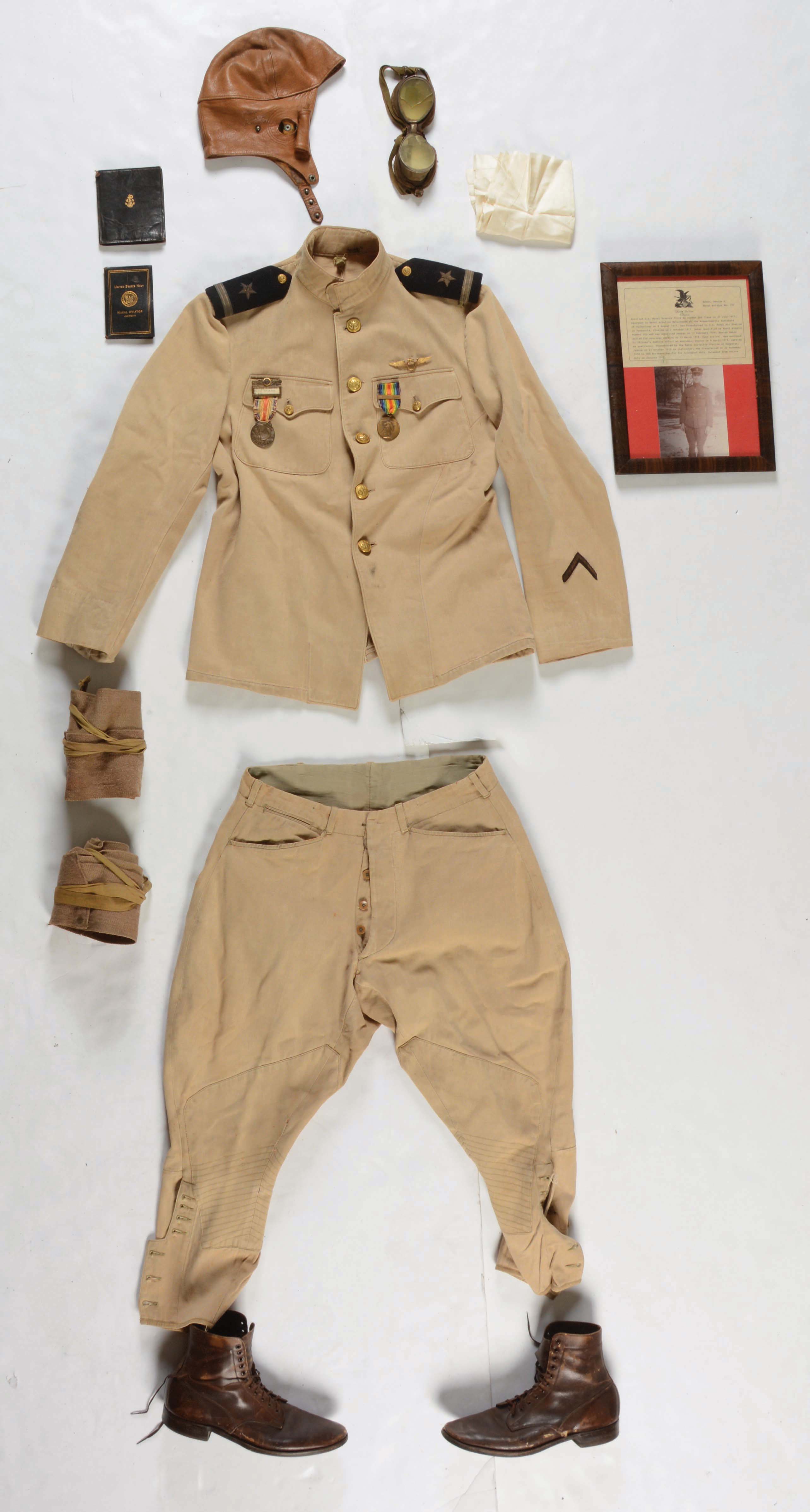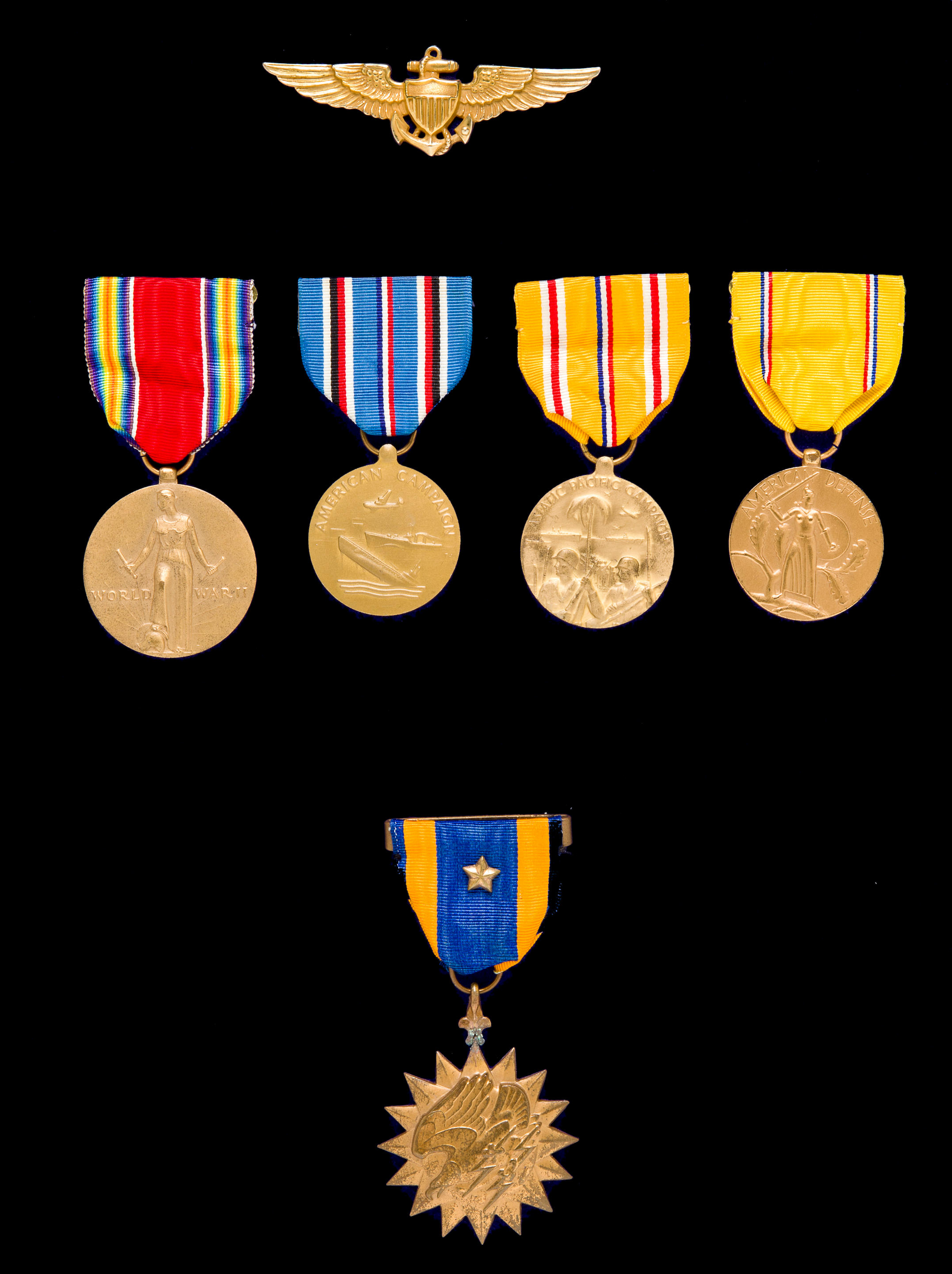35 items, including insignia/buttons. Frederick Wyllys Caldwell (1892-1921) came from a long line of servicemen, stretching back to the French and Indian War, so it was little surprise when he enlisted in the U.S. Army Aviation Service in 1917. Attending ground school at MIT, he qualified as aerial observer at Langley Field, aerial gunner at Taliaferro Field, and received his pilot’s license (#2278) on Sept. 22, 1918, after attending flight school at Love Field, Dallas, TX. His flying skill was such that he was assigned as a flight instructor, returning to Taliaferro Field at Ft. Worth, TX. After serving in the 48th Aero Squadron, he was assigned special flight duty in the Panama Canal Zone in 1919. He transferred to the Air Service Signal Reserve Corps in September 1919 after his tour of duty, and purchased a hydroplane to give tourist flights at Lake Chautauqua, NY. On Aug. 31, 1921, Caldwell took his visiting sister on a flight around the lake, and after dropping her off at the train station, returned to his aircraft to take two tourists up. It was during this flight that the plane nosed down and crashed into the lake near Bemus Point, killing the pilot. His passengers were able to survive by clinging to the wreckage of the plane until help arrived. This archive includes two diaries by Caldwell. The first covers Dec. 1, 1917, to May 21, 1918, then resumes March 27, 1919, in Panama and ends June 26, 1919. The first section chronicles Caldwell’s journey from basic training, through flight school, to becoming an officer and pilot in the U.S. Army Air Service. From KP duty to the hazards of flight school at Love Field (where at least two planes a day seem to break down or get damaged by students). The section covering Caldwell’s 1919 service as an Army pilot in Panama sounds like a pretty nice billet for a young single man ? flying, boating, hunting, trips to the beach, and nights on the town. The diary also offers plenty of reminders that only eleven years had passed since the U.S. Army had bought its first airplane from the Wright brothers. The Curtis N-9 seaplanes are often out of service, and pilots scramble for flight time in the DeHavilland DH4 or other auxiliary craft. The second journal begins Aug. 1, 1921, with the entry Left Cleveland at 7:20 AM. Waldameer 8:15. Land in dark and alas in very rough sea. Lucky we got out of this alive. This journal records Caldwell’s career as seaplane barnstormer on Lake Chautauqua near the tourist site of Bemus Point, the fares (or lack thereof), the weather, and dealing with the daily quirks of a cantankerous aircraft. The last entry was on Aug. 28, three days before his death: Get up at 8 o’clock. Bill and I fly up to the point. Have trouble with motor. No pep & overheating. Started to look for drowned boy but had more trouble and had to take back. Left ship at Bemus Point. Come down with Sullivan and get the covers. Go back and listen to Gilliland’s Band. Slick music. Both diaries give a strong sense of Caldwell’s strength of character and fortitude. Other items in this archive include Caldwell’s U.S. Army Air Service wings and insignia, a “sweetheart pin” of USAAS wings, and a Blue Star Air Service pin that his mother or father would have worn during the war to denote a son flying for Uncle Sam. Also included is a large framed portrait of Caldwell in uniform, showing a strong, handsome man; a real photo postcard of Caldwell and his father, with the senior Caldwell sitting at the controls of a flying boat; and a photo of Caldwell in uniform driving a convertible. Caldwell’s diplomas from ground school, certification as aerial observer and gunner, commission as 2nd Lieut. in the Aviation Section of the Signal Corps, his discharge papers as well as 1920 military ID and pilot’s license issued by the Aero Club of America in 1918 bear witness to his service (the Aero Club licensed military pilots in WWI). Other interesting items are his certificate of induction into the Freemasons while
35 items, including insignia/buttons. Frederick Wyllys Caldwell (1892-1921) came from a long line of servicemen, stretching back to the French and Indian War, so it was little surprise when he enlisted in the U.S. Army Aviation Service in 1917. Attending ground school at MIT, he qualified as aerial observer at Langley Field, aerial gunner at Taliaferro Field, and received his pilot’s license (#2278) on Sept. 22, 1918, after attending flight school at Love Field, Dallas, TX. His flying skill was such that he was assigned as a flight instructor, returning to Taliaferro Field at Ft. Worth, TX. After serving in the 48th Aero Squadron, he was assigned special flight duty in the Panama Canal Zone in 1919. He transferred to the Air Service Signal Reserve Corps in September 1919 after his tour of duty, and purchased a hydroplane to give tourist flights at Lake Chautauqua, NY. On Aug. 31, 1921, Caldwell took his visiting sister on a flight around the lake, and after dropping her off at the train station, returned to his aircraft to take two tourists up. It was during this flight that the plane nosed down and crashed into the lake near Bemus Point, killing the pilot. His passengers were able to survive by clinging to the wreckage of the plane until help arrived. This archive includes two diaries by Caldwell. The first covers Dec. 1, 1917, to May 21, 1918, then resumes March 27, 1919, in Panama and ends June 26, 1919. The first section chronicles Caldwell’s journey from basic training, through flight school, to becoming an officer and pilot in the U.S. Army Air Service. From KP duty to the hazards of flight school at Love Field (where at least two planes a day seem to break down or get damaged by students). The section covering Caldwell’s 1919 service as an Army pilot in Panama sounds like a pretty nice billet for a young single man ? flying, boating, hunting, trips to the beach, and nights on the town. The diary also offers plenty of reminders that only eleven years had passed since the U.S. Army had bought its first airplane from the Wright brothers. The Curtis N-9 seaplanes are often out of service, and pilots scramble for flight time in the DeHavilland DH4 or other auxiliary craft. The second journal begins Aug. 1, 1921, with the entry Left Cleveland at 7:20 AM. Waldameer 8:15. Land in dark and alas in very rough sea. Lucky we got out of this alive. This journal records Caldwell’s career as seaplane barnstormer on Lake Chautauqua near the tourist site of Bemus Point, the fares (or lack thereof), the weather, and dealing with the daily quirks of a cantankerous aircraft. The last entry was on Aug. 28, three days before his death: Get up at 8 o’clock. Bill and I fly up to the point. Have trouble with motor. No pep & overheating. Started to look for drowned boy but had more trouble and had to take back. Left ship at Bemus Point. Come down with Sullivan and get the covers. Go back and listen to Gilliland’s Band. Slick music. Both diaries give a strong sense of Caldwell’s strength of character and fortitude. Other items in this archive include Caldwell’s U.S. Army Air Service wings and insignia, a “sweetheart pin” of USAAS wings, and a Blue Star Air Service pin that his mother or father would have worn during the war to denote a son flying for Uncle Sam. Also included is a large framed portrait of Caldwell in uniform, showing a strong, handsome man; a real photo postcard of Caldwell and his father, with the senior Caldwell sitting at the controls of a flying boat; and a photo of Caldwell in uniform driving a convertible. Caldwell’s diplomas from ground school, certification as aerial observer and gunner, commission as 2nd Lieut. in the Aviation Section of the Signal Corps, his discharge papers as well as 1920 military ID and pilot’s license issued by the Aero Club of America in 1918 bear witness to his service (the Aero Club licensed military pilots in WWI). Other interesting items are his certificate of induction into the Freemasons while















Testen Sie LotSearch und seine Premium-Features 7 Tage - ohne Kosten!
Lassen Sie sich automatisch über neue Objekte in kommenden Auktionen benachrichtigen.
Suchauftrag anlegen